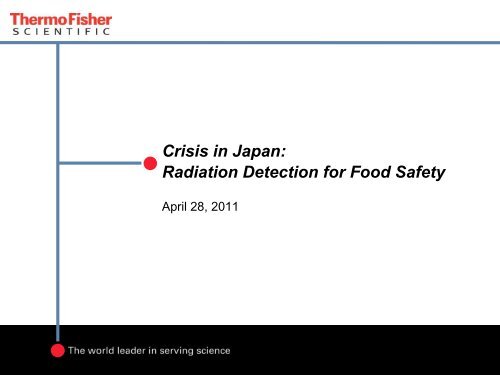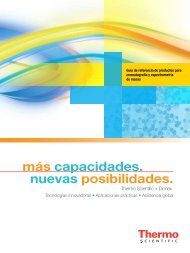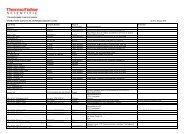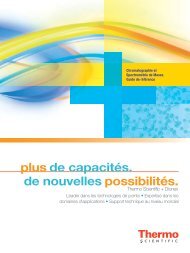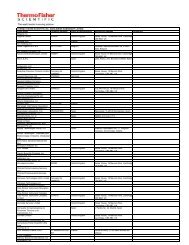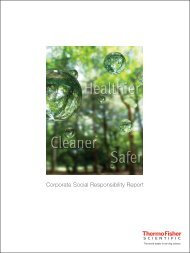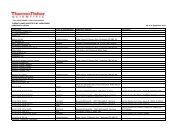Crisis In Japan: Radiation Detection For Food Safety
Crisis In Japan: Radiation Detection For Food Safety
Crisis In Japan: Radiation Detection For Food Safety
You also want an ePaper? Increase the reach of your titles
YUMPU automatically turns print PDFs into web optimized ePapers that Google loves.
<strong>Crisis</strong> in <strong>Japan</strong>:<br />
<strong>Radiation</strong> <strong>Detection</strong> for <strong>Food</strong> <strong>Safety</strong><br />
April 28, 2011
2<br />
Enabling Our Customers to Make the World…<br />
Healthier Cleaner Safer
3<br />
Speakers<br />
Guest Speaker: Ken Kerns<br />
Consultant to the <strong>In</strong>ternational Atomic Energy Agency in Vienna,<br />
Austria and Associate Director, Environmental Health and <strong>Safety</strong> at<br />
Iowa State University.<br />
Mr. Kerns is a safety professional with over 25 years of experience in<br />
radiation safety and emergency response planning. Areas of expertise<br />
include radiological emergency response, emergency planning,<br />
exercise planning and control, safety and technical training, and site<br />
remediation.<br />
Bob MacKenzie<br />
Program Manager for New Technologies at the <strong>Radiation</strong> Measurement and Security<br />
<strong>In</strong>strumentation (RM&SI) business unit of Thermo Fisher Scientific.<br />
Mr. MacKenzie been in the Nuclear instrumentation business for 40 years. <strong>In</strong> his early career<br />
he was a reactor and neutron physicist. His experience encompasses instrumentation of all<br />
types ranging from instruments deploying simple Geiger-Mueller tubes through to those using<br />
sophisticated High-Purity Germanium based systems.
4<br />
<strong>In</strong>troduction and Current Situation<br />
• Fukushima, <strong>Japan</strong> - 2011<br />
• Earthquake and tsunami (March 11)<br />
• 14,000 dead, 14,000 still missing<br />
• 500,000 left homeless<br />
• Shortage of food, water and medical support<br />
• Dai-ichi Reactors<br />
• Connection to the electrical grid was broken<br />
• Backup generators failed<br />
• All power for cooling was lost to reactors<br />
• All efforts were focused on cooling reactors<br />
• Controlled pressure releases were required<br />
• Radioactive water leaked into ocean<br />
• Reactor situation still serious but manageable
5<br />
Fukushima Daiichi Nuclear Power Plant<br />
Unit 4<br />
Unit 3<br />
Unit 2<br />
Units 5, 6<br />
Unit 1<br />
At the time of the earthquake<br />
Reactors 1, 2 and 3 operating<br />
Reactors 4, 5 and 6 shutdown for<br />
maintenance, inspection, refueling
6<br />
<strong>Radiation</strong> Releases from Daiichi Reactors<br />
• Atmospheric<br />
• Over pressurization of reactors<br />
• Controlled released<br />
• Uncontrolled releases<br />
• Winds away from island initially<br />
• Sea and groundwater<br />
• Water pooled around reactors<br />
• Leaks from fuel storage pools<br />
• Leaks from cracked pipe in unit 2<br />
• Waste treatment plant will be used for<br />
temporary storage
7<br />
Radioactive Materials Released in <strong>Japan</strong><br />
Iodines<br />
Particulates<br />
Noble Gasses<br />
Fissionable<br />
Materials<br />
• I-131, I-129<br />
• High affinity for thyroid gland<br />
• Stable potassium Iodide (KI) used as prophylaxis<br />
• Cs-137, Cs-134, Sr-90<br />
• <strong>In</strong>ternal and external hazards<br />
• Longer half-lives<br />
• Xe-137, Kr-90<br />
• <strong>In</strong>ert – but decays to other isotopes<br />
• External Hazard only<br />
• U-235, Pu-239<br />
• <strong>In</strong>ternal hazard<br />
• Very long half-lives
8<br />
<strong>Radiation</strong> Basics
9<br />
Important Units and Limits<br />
Activity is a measure<br />
of the amount of<br />
radioactive material<br />
Dose is the amount of<br />
energy imparted on<br />
the body<br />
Dose Limits<br />
Annual Background<br />
Dose<br />
• Curies (US) (3.7E10 disintegrations/second)<br />
• Becquerel (SI) (1 disintegration/second)<br />
• Units are Rem (US) and Sievert (SI)<br />
• 1Sv = 100 Rem<br />
• Occupational = 5 Rem (50 mSv)/year<br />
• General Public = 100 mRem (1mSv) /year)<br />
• Emergency worker = 10 Rem (100 mSv)<br />
• 620 mRem (6.2 mSV) / year<br />
• Varies according to location
10<br />
US Average Background <strong>Radiation</strong> Dose
11<br />
How Can <strong>Food</strong> Products Become Radioactive?<br />
Airborne<br />
radioactive<br />
materials<br />
contaminate<br />
food surfaces<br />
or animal feed.<br />
Bioaccumulation<br />
through soil,<br />
water, or food<br />
chain.<br />
Source: World Health Organization<br />
Releases to<br />
water affect<br />
fish, plants,<br />
and irrigation.<br />
The severity is<br />
determined by<br />
radionuclide<br />
mix and levels.
12<br />
<strong>Radiation</strong> Impact on <strong>Food</strong><br />
March 20,<br />
2011<br />
April 8,<br />
2011<br />
April 11,<br />
2011<br />
Currently<br />
• <strong>Japan</strong> placed restrictions on some food produced in two provinces<br />
• High levels of Cs-137 in spinach and I-131 in milk.<br />
• <strong>Japan</strong> lifted restrictions on milk and spinach and other vegetables.<br />
• <strong>Japan</strong> will restrict rice planting in areas where radiation levels are higher<br />
than limits set by food regulations.<br />
• US FDA performed 1,017 field tests for radionuclide contamination.<br />
• No contamination found.<br />
• 41 food types including 2 fish.<br />
• No additional contaminated foods identified.<br />
• Seawater within 20 Km of plant with significant levels of contamination
13<br />
Global Reactions to <strong>Radiation</strong> in <strong>Food</strong><br />
Many countries have<br />
banned food imports<br />
from <strong>Japan</strong>.<br />
“FDA does not have<br />
concerns with the safety<br />
of imported food products<br />
that have already reached<br />
the U.S.”<br />
(4/2/11 <strong>Radiation</strong> <strong>Safety</strong> Report)<br />
US FDA:<br />
“Based on current<br />
information, there is<br />
no risk to the U.S.<br />
food supply”<br />
The FDA continues to<br />
monitor the situation<br />
and will restrict<br />
imports if necessary.
14<br />
Radiological Monitoring Results (<strong>Japan</strong>)<br />
<strong>Food</strong><br />
• 23 food samples were collected on April 8,15, 17 and 18<br />
• I-131, Cs-134 and/or Cs-137 were either not detected or were<br />
below the regulation values set by the <strong>Japan</strong>ese authorities.<br />
Drinking Water<br />
• I-131 and Cs-137 are far below restriction levels<br />
• Recommendations for restrictions for infants based on I-131 in<br />
place in 1 village of Fukushima prefecture as precautionary<br />
measure<br />
(IAEA- 19 April 2011)
15<br />
Toxicology<br />
• Potential for increased thyroid nodules and cancers in children due to<br />
ingestion of I-131<br />
• Very low potential due to:<br />
• vigilant monitoring<br />
• food restrictions and<br />
• KI distribution<br />
• I-131 has an 8-day half-life so it will fully decay in less than 3 months<br />
• Potential for increased cancer rate from uptake of other radioisotopes<br />
• Risk (less than 0.1%) is much lower than total cancer risk (40%)<br />
• Leukemia is most likely cancer<br />
• <strong>Radiation</strong>-induced cancers are not distinguishable from other causes
16<br />
Potential for Future <strong>Food</strong> Contamination<br />
Unlikely Very Low Possible<br />
Milk Rice Fish<br />
Cheese Tubers Kelp<br />
Meat Leafy Vegetables Shellfish<br />
Packaged <strong>Food</strong>s Produce
17<br />
Best Case / Worst Case Scenario<br />
Best Case<br />
No additional<br />
releases of<br />
radioactive material<br />
Some crop and<br />
fishing restrictions<br />
are maintained<br />
Continued<br />
monitoring efforts<br />
Consumer<br />
confidence restored<br />
Worst Case<br />
Loss of cooling and<br />
major release<br />
Widespread<br />
contamination and<br />
global food impact<br />
Countries impose<br />
protection practices
18<br />
Contact <strong>In</strong>formation<br />
Ken Kerns, Associate Director<br />
Environmental Health and <strong>Safety</strong><br />
Iowa State University<br />
2809 Daley Drive, Ames, IA 50011-3660<br />
515-294-0746 (office)<br />
kckerns@iastate.edu
19<br />
Overview of Measurement Tools<br />
Surface Monitoring for<br />
Contamination<br />
What? On lettuce, grass,<br />
swipes<br />
Bulk Monitoring (Gross<br />
Gamma <strong>Radiation</strong>)<br />
Drinking Water, Milk, Meat,<br />
Fish, Mushrooms, Nuts, etc.<br />
Bulk Monitoring (Simple<br />
Gamma Spectroscopy)<br />
Drinking Water, Milk, Meat,<br />
Fish, Mushrooms, Nuts, etc.<br />
Sensor Used Geiger Mueller Tube Scintillator (e.g. NaI(Tl)) NaI(Tl) Scintillator<br />
Who? Emergency Responder<br />
When?<br />
Where?<br />
<strong>Detection</strong><br />
Limits for<br />
I-131 (Typical)<br />
<strong>In</strong>strument<br />
Needs<br />
Thermo<br />
Scientific<br />
Solution<br />
Hours, Days after<br />
Accident<br />
Local Agricultural<br />
Environment<br />
Use weather information<br />
<strong>Food</strong> Distribution Chain<br />
<strong>Radiation</strong> <strong>Safety</strong> Technologist<br />
Emergency Responder<br />
Days, Weeks, Months after<br />
Accident<br />
Agricultural Regions<br />
Drinking Water Supply<br />
Fisheries<br />
Milk Production Sites<br />
Laboratory<br />
Technologist<br />
Bulk Monitoring<br />
(Sophisticated Gamma<br />
Spectroscopy)<br />
Drinking Water, Milk, Meat,<br />
Fish, Mushrooms, Nuts, etc.<br />
High-Purity Germanium<br />
Detector<br />
Technologist<br />
<strong>Food</strong> <strong>Safety</strong> Scientist<br />
Gamma Spectroscopist<br />
Weeks, Months, Years Months, Years<br />
Monitoring Program with<br />
Frequency and Location<br />
Determined by Analysis<br />
Monitoring Program with<br />
Frequency and Location<br />
Determined by Analysis<br />
~ 4 kBq/l ~300 Bq/l ~60 to 120 Bq/L (w/wo Lead) Very Low<br />
Fast: Go/No Go<br />
Decision<br />
Easy to Use:<br />
Emergency Response<br />
Low Cost: Many<br />
monitoring points<br />
Analysis: Semi-quantitative<br />
Easy to Use: Many users<br />
Low Cost: Many<br />
Measurements<br />
Analysis: Semi-quantitative<br />
Easy to Use: Many users<br />
Moderate Cost: Extensive<br />
Program<br />
RadEye B20 RadEye PRD-S RadEye SX<br />
Analysis: Fully Quantitative<br />
Cost: Not a Driving Factor<br />
HPGe Nuclide<br />
Analysis System
20<br />
Methods of Analysis<br />
Sample Sample prep Methods of Analysis<br />
Air<br />
Air Sampler and<br />
Cartridge/Filter<br />
Nuclide Specific<br />
Water Desiccate on filter Low Level Alpha/Beta<br />
<strong>Food</strong> Cut and weigh Gross Gamma<br />
Grass and vegetation None Scan with Large Area GM Tube<br />
Packages None Scan with Large Area GM Tube<br />
Personnel Protection Products Application<br />
Badges Active and passive dosimetry Total dose<br />
<strong>In</strong>strument (pager) RadEye – B20 Surface contamination<br />
<strong>In</strong>strument (pager) RadEye – PRD Dose rate and thyroid
21<br />
Measurement Considerations<br />
• <strong>Food</strong> (including milk and drinking water) measurements to<br />
Derived <strong>In</strong>tervention Level (DIL - USA), does not require<br />
sophisticated sample preparation<br />
• Knowledge of weight and volume necessary to normalize results<br />
• Fruits and vegetables (above ground) - surface contamination<br />
• Swipe or direct measurement<br />
• Measurements to sub-pCi levels require sophisticated sample<br />
preparation and HPGe specific nuclide analysis system<br />
• Air sampling<br />
• Typically soil measurements are not common (remediation task)<br />
DIL Levels Radionuclide Group (Bq/kg)*<br />
Iodine-131 170<br />
Cesium-134 + Cesium-137 1200<br />
*FDA Website
Thermo Scientific RadEye B20<br />
• A modern compact multi-purpose<br />
contamination meter<br />
• Quickly detects existence of radioactivity on<br />
food, soil and swipes (predominantly via beta<br />
radiation, incl. I-131, Cs-137, Sr-90)<br />
• Detects alpha, beta, gamma and X-ray<br />
radiation<br />
• Lightweight, compact and rugged<br />
• Standard AAA-cell batteries for over 500<br />
hours operation time<br />
• Removable Energy Filters Available<br />
• Energy filter for directional dose<br />
• Energy filter for ambient dose<br />
• Alpha-rejection filter for quick estimation of<br />
alpha contamination in emergency response<br />
situations<br />
22
Gamma Measurement in <strong>Food</strong>, Liquids with RadEye PRD<br />
• Highly sensitive Gamma radiation detection<br />
using NaI(Tl) Detector<br />
• Immediate indication on lowest levels of<br />
gamma radiation (> 150 cps / µSv/h Cs-137)<br />
• The RadEye PRD can quickly screen for the<br />
existence of significant radiation levels on<br />
food, soil and wipes within seconds<br />
• The same instrument can perform quantitative<br />
sample measurements<br />
23<br />
The RadEye PRD can be used for<br />
quick scans for radioactive Iodine<br />
RadEye PRD in lead shieding kit for<br />
gamma detection in food samples<br />
Typical detection limit (5 min):<br />
120 Bq/l (or Bq/g) for I-131<br />
300 Bq/l (or Bq/g) for Cs-137<br />
RadEye PRD in sample charger kit for<br />
gamma detection in liquid samples<br />
Typical detection limit (5 min):<br />
120 Bq/l (or Bq/g) for I-131 in water<br />
300 Bq/l (or Bq/g) for Cs-137 in water
High Sensitivity Gamma Measurement RadEye SX/SPA3<br />
24<br />
• Gamma food monitoring via<br />
highly sensitive<br />
2 adjustable energy windows<br />
are measured simultaneously<br />
• The kit comprises SPA3 2”x2”probe<br />
with connection cable,<br />
desktop stand and Marinelli<br />
beaker set.<br />
• RadEye SX provides scaler<br />
mode with adjustable<br />
measurement time<br />
• Optional Pb-shield for reduced<br />
measurement time<br />
Typical detection limit (5 min):<br />
100 Bq/l (or Bq/g) for I-131 in water<br />
100 Bq/l (or Bq/g) for Cs-137 in water
25<br />
RadEye HEC for Alpha-emitters<br />
• Alpha-Beta Sample Counter<br />
• Simultaneous alpha and beta radiation<br />
measurements.<br />
• Approx. 800 hrs operation time (battery)<br />
• <strong>In</strong>ternal data storage (4500 values)<br />
• USB interface to PC<br />
• The system incorporates a 2" dual<br />
scintillation phosphor detector<br />
• One sliding drawer accommo-dating a 2"<br />
diameter sample.
26<br />
HPGe Specific Nuclide Analysis System<br />
• High Resolution<br />
• Specific nuclide measurement (nuclide vector)<br />
• Components<br />
• High-Purity Germanium Detector<br />
• Lead Shield<br />
• Electronics<br />
• PC and Software<br />
• Footprint Considerations<br />
• Weight: >1,000 pounds<br />
• <strong>For</strong>m factor: Floor Standing
27<br />
RadEye Quantitative Measurement <strong>In</strong>struments<br />
Product B20-ER PRD-S SX/SPA3 HEC<br />
Category Surface Bulk Bulk Surface<br />
Beta radation<br />
Gamma radiation<br />
Alpha/beta radiation<br />
<strong>Detection</strong> Limit<br />
I-131, 1 min (Bq/l)<br />
~4000 ~300 ~120<br />
(60 w/ Pb shield)<br />
na
28<br />
Thank You. <strong>For</strong> more information…<br />
<strong>Radiation</strong> Measurement<br />
Headquarters<br />
US<br />
27 <strong>For</strong>ge Parkway<br />
Franklin, MA 02038 USA<br />
+1 (800) 274-4212<br />
+1 (508) 520-2815 fax<br />
United Kingdom<br />
Bath Road Beenham<br />
Reading, Berkshire<br />
RG7 5PR, UK<br />
+44 (0) 118 9712121<br />
+44 (0) 118 9712835 fax<br />
+011 65 64789505 fax<br />
Singapore<br />
11 Biopolis Way #12-07/08<br />
Helios Building<br />
Singapore 138662<br />
+011 65 68729724<br />
Germany<br />
Frauenauracher Strasse 96<br />
Erlangen 91056 Germany<br />
+49 9131 909-226<br />
+49 9131 909-205 fax<br />
<strong>In</strong>dia<br />
Plot No. C -327,<br />
T.T.C. <strong>In</strong>dustrial Area,<br />
Pawne<br />
Navi Mumbai 400 705, <strong>In</strong>dia<br />
+91 22 41578800<br />
+91 22 41578801 fax<br />
General sales inquires email: info.eid.thermofisher.com<br />
<strong>Japan</strong> <strong>Crisis</strong> Response website: www.thermofisher.com/global/en/products/japan/index.html<br />
RadEye products: www.thermoscientific.com/ecomm/servlet/newsdetail?storeId=11152&contentId=52697<br />
<strong>Radiation</strong> <strong>Safety</strong>: www.thermoscientific.com/ecomm/servlet/productscatalog_11152_10443_80427_-1_4<br />
<strong>Food</strong> <strong>Safety</strong> website: www.thermofisher.com/foodsafety<br />
<strong>Japan</strong> Distibutor for <strong>Radiation</strong> Measurement Devices<br />
SEIKO EG&G Co.,Ltd., Tokyo Office, Phone +81-3-5542-3104 www.sii.co.jp/segg/<br />
China<br />
7th Floor, Tower West, Yonghe<br />
Plaza<br />
No. 28 Andingem East Street<br />
Beijing, 100007 China<br />
+86 10 8419 3588<br />
+86 10 8419 3581 fax<br />
<strong>Japan</strong><br />
SEIKO EG&G Co.,Ltd.<br />
Tokyo Office<br />
+81-3-5542-3104<br />
www.sii.co.jp/segg/


